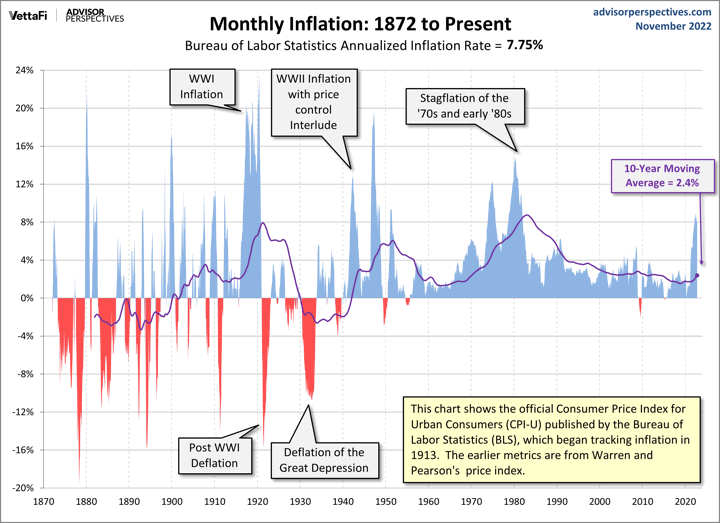Advisor Perspectives has a nice chart of 150 years of historical inflation (1872-2022). I appreciate that it includes both the short-term monthly inflation numbers as well as the 10-year rolling average over this long period of time.

A few basic observations:
- From a long-term perspective, there have been many large sharp spikes in inflation throughout the entire period. Inflation has been a persistently recurring concern.
- From roughly 1872-1940, there were extreme swings between both high inflation and high deflation. Of course, this was also when the dollar was (mostly) on the gold standard.
- From roughly 1950 onward, the rolling 10-year average for inflation has still varied from ~2% to ~9% annually. Given our current low 10-year average, inflation could continue to be elevated for many years and not look out of place on this chart.
My primary takeaway is to always stay mindful of long-term inflation risk. I don’t know what inflation will be next month or next year, but I am confident that it’s coming sooner or later. Some applications (my opinion):
- The 30-year fixed rate mortgage continues to be a great inflation hedge. (Even at high interest rates, that might soon result in lower prices.) As long as you lock in a monthly payment that you can comfortably afford and plan to stay a while, your monthly mortgage payment will only effectively get cheaper over time as inflation eats away at it. If rates drop, you can refinance. If rates rise, you can keep it forever and even rent the property out if you move, as high rates means inflation likely boosted rents while your mortgage payment stayed the same.
- On the flip side, according to Macrotrends, the a 30-year Treasury bond yielded only 1% a year back in 2020. Long-term nominal bonds became a popular portfolio diversifier while rates were dropping (performance chasing), but in reality they became a ticking inflation bomb. I’m still avoiding long-term nominal bonds today.
- A lifetime annuity has definite upsides, but inflation will eat away at the spending power over what could be 30 years. Maybe you’ll get older and spend less each year anyway, but I’d still maintain other assets (like stocks) to hedge that inflation risk. I like single premium immediate annuities as a possible tool for retirement income, but not as the only or primary tool.
- TIPS are complex yet intriguing. I’m still not sure what the best play is right now, but I am happy to keep holding them as part of my bond portfolio. I’m leaning towards moving away from ETFs and more towards a ladder of individual bonds, especially if the real rates on long-term TIPS go any higher.
 The Best Credit Card Bonus Offers – 2025
The Best Credit Card Bonus Offers – 2025 Big List of Free Stocks from Brokerage Apps
Big List of Free Stocks from Brokerage Apps Best Interest Rates on Cash - 2025
Best Interest Rates on Cash - 2025 Free Credit Scores x 3 + Free Credit Monitoring
Free Credit Scores x 3 + Free Credit Monitoring Best No Fee 0% APR Balance Transfer Offers
Best No Fee 0% APR Balance Transfer Offers Little-Known Cellular Data Plans That Can Save Big Money
Little-Known Cellular Data Plans That Can Save Big Money How To Haggle Your Cable or Direct TV Bill
How To Haggle Your Cable or Direct TV Bill Big List of Free Consumer Data Reports (Credit, Rent, Work)
Big List of Free Consumer Data Reports (Credit, Rent, Work)
Is the general consensus that the official CPI inflation numbers are accurate, or is it understated by making tweaks to the way it is measured. The reason I ask is because I wonder if the US federal government has any vested interest in understating the official CPI numbers since so many things are tied to those numbers, so as the amount of social security Cost of Living Adjustments? I am generally not a conspiracy theory person but I do not want to be naïve either.
Social Security payments are indexed to CPI, but so is the social security wage base, so the government is fairly well hedged from that perspective. In fact, since Social Security has been in a surplus position for the last several decades, overstating (rather than understating) inflation would actually have been beneficial to the program because it would increase the spread in dollars between collections (the wage base) and payments (social security payments). So as conspiracy theories go, that one isn’t particularly compelling to me.
“Social Security payments are indexed to CPI, but so is the social security wage base, so the government is fairly well hedged from that perspective.”
For this to balance out though, doesn’t this require that wages keep up with inflation for all those people with wages below the wage base level ($147K – which is most of the population?)
Wages most definitely have not kept up over the last year, so it would seem that this creates a significant deficit (i.e., social security payments continue to rise at the CPI inflation rate while taxes from social security have not due to wages not keeping up with inflation)
An entire book could be written about this topic. There are some controversial changes such as hedonic adjustments, but on the flipside – you can see the logic. Obviously a computer sold 20 years ago is not an apples to apples comparison to one sold now. Focusing entirely on price is wrong-headed too.
The most important thing to note is the basket itself. The CPI basket was designed to encompass the everyday expenditures of retirees. It was not meant to be a proxy for the entire economy. The GDP deflator would be the tool for that